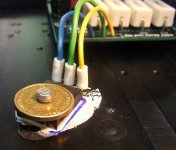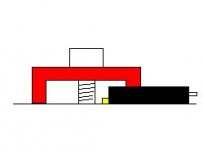I think a common goo mistake is to apply too much - the thermal paste or goo is not supposed to do more than just fill out the cracks.
Here are some guides to apply paste to cpus - the theory applies equally to mosfets.
Arctic Silver Incorporated - Arctic Silver 5 Instructions
I remember that advice from building computers - use a very thin evenly applied layer. However, in my case, I apparently used too thin a layer as it didn't fill in all areas and left some air pockets. So a little squeeze out is better than not enough
nope - if you use decent "security" washers ; dunno what's English word for these , but that's small spring steel washer , right under screw head
I think you mean lock washers. I haven't used them. I use fender washers, I find, at least with sil-pads, they distribute the torque much more evenly than without.
I have noticed they never need to be retorqued but IMO it's just good practice to check.
you MUST use fender washer , but - beside fender washer - I'm using lock washer to ensure constant pressure - even if I'm mostly using mica & goo
funny - I found that old ( non valid , but also even valid ) coins are best for purpose .... almost as they are last pieces from personal stash of Baron Krupp ......
) coins are best for purpose .... almost as they are last pieces from personal stash of Baron Krupp ...... 
funny - I found that old ( non valid , but also even valid
 ) coins are best for purpose .... almost as they are last pieces from personal stash of Baron Krupp ......
) coins are best for purpose .... almost as they are last pieces from personal stash of Baron Krupp ...... 
Attachments
you MUST use fender washer , but - beside fender washer - I'm using lock washer to ensure constant pressure - even if I'm mostly using mica & goo
funny - I found that old ( non valid , but also even valid) coins are best for purpose .... almost as they are last pieces from personal stash of Baron Krupp ......

Way to throw money at the problem!
you MUST use fender washer , but - beside fender washer - I'm using lock washer to ensure constant pressure - even if I'm mostly using mica & goo
funny - I found that old ( non valid , but also even valid) coins are best for purpose .... almost as they are last pieces from personal stash of Baron Krupp ......

What are those white insulators on the joints to the mosfet?
Jim
What are those white insulators on the joints to the mosfet?
Jim
That's Marshmallow Fluff
That's Marshmallow Fluff
Or silicone grease. But with Zen Mod you never can tell.
I believe I said Papa also uses...Ummm.
Looks like Papa uses the same as most of us; washer and lock nuts (aircraft nuts).
Ron
They look like allen head screws.
I beleive the term is Socket Head Cap Screw. The ones pictured look Stainless or plated. "aircraft nuts" is not even found in Wikipedia??? The English term would ussually be screw or possibly bolt. I did not see any nuts of interest? Aicraft or otherwise. Ummm, were you thinking of balls to the wall
That looks like a spilt lock washer ZM. There are other wavy looking " springy" washer devices that can work well but, you need to keep equal pressure all around and if not sized properly they won't be.nope - if you use decent "security" washers ; dunno what's English word for these , but that's small spring steel washer , right under screw head
I guess the real reason for this post, other than feeling piled on when only trying to help, can be found in the Zen Version 8 article, by The One an Only himself: "Q2 is mounted on a heat sink like any other power device, but we pay special attention to the mounting of Q1. I mounted mine directly on an anodized sink, using thermal grease and about a pound of pressure from a clip."
AaHmmm
Last edited:
And, traditionally Socket Head Cap Screws were easily available in SAE (Probably only a North American standard) grade 5 stainless or grade 8 carbon black. Very good quality stuff. Today however you can get cheap copies and plated decorative ones of all types.
When I experimented with the LU1014D I used a clamp, with a screw, as in the profile view below. The JFET has no mounting hole,
When I experimented with the LU1014D I used a clamp, with a screw, as in the profile view below. The JFET has no mounting hole,
Attachments
Surely your not suggesting that it is electronically capacitive???
It is. It did have problems with the original CPU dies which had components on the top (the so-called 'naked' dies). All modern CPUs have heatspreaders - this is less of a problem now. Still, you never know.
From the horse's mouth:
(While much safer than electrically conductive silver and copper greases, Arctic Silver 5 should be kept away from electrical traces, pins, and leads. While it is not electrically conductive, the compound is very slightly capacitive and could potentially cause problems if it bridges two close-proximity electrical paths.)
Arctic Silver Incorporated - Arctic Silver 5
I use 100 to scuff up the surface and then lap it finer. The lapping to very fine is probably not necessary - I really would not go above 800 for a 30 watt device the size of a TO3-P. The difference will be insignificant. Mirror finish emerged at a time when CPUs were pushing out around 60 watts out of a surface the size of a TO-220 contact tab, or even smaller. There even the slightest differences could be measured and seen - through a fried CPU, mostly.
It is surely possible to do it, but I'm not sure it provides any additional benefit in terms of device temperature. It should look nicer, though
I ran up a quick sim on LTspice, with the load changing from 1.3A (the quiescent drain with no output) to 6.3A (add 5 amps load). Didn't see any signs of ringing or other nasties, just the output voltage drooping by a fraction of a volt or so. Going to try and do some screen captures and put them up here.
I believe the term is
According to the Swedes it should be in-sex-screw, my personal favorite.

I still have Allen keys for various dimension series of the Hex(ed) bolt twilight zone era.
Are we torquing truck tires or military aircraft egress/environmental equipment down or simply snugging up a plastic wafer?
A couple of the semi companies specify torque for their devices.
A couple of the semi companies specify torque for their devices.
Ok, you could probably achieve that specification with nylon fasteners.
I'm guessing that aircraft grade fasteners are not required.
Is this a good option ?
An externally hosted image should be here but it was not working when we last tested it.
- Home
- Amplifiers
- Pass Labs
- F5 power amplifier

